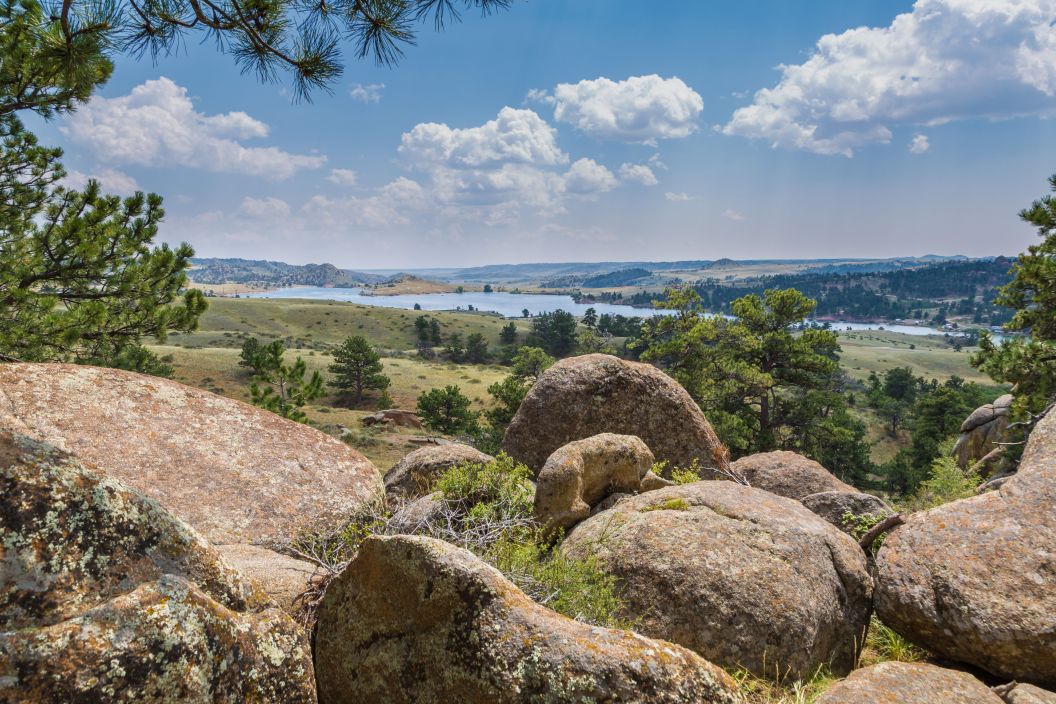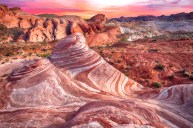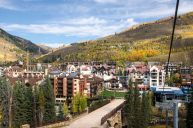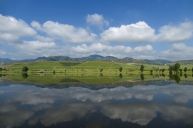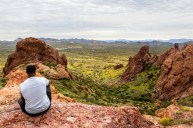Wyoming's capital city has a storied and sometimes sordid history tied to the Wild West and the building of the Union Pacific Railroad, which cuts through it. But Cheyenne is not just a place to be left in the chapters of the American West. It's maintained its Western roots and charm while navigating into modern times.
Located an hour and a half from Denver International Airport, the city is filled with friendly, welcoming people eager to share their favorite things to do in Cheyenne.
Why Cheyenne Is Worth a Visit
While most capital cities have moved away from their roots, Cheyenne still has a small-town feel, a feat few other capital cities can boast. On top of that, it's surrounded by a natural beauty that seems almost unheard of in other cities.
Parks and museums are everywhere you look, but if you also want a taste of the great outdoors, you can head just 24 miles out of the city to Curt Gowdy State Park where you'll see pronghorn and other wildlife along the way.
I was able to see the city with Visit Cheyenne, and it was an amazing experience with quite a few surprises. These are my favorite outdoorsy things to do in Cheyenne, Wyoming.
1. Stroll Through Holliday Park and See the Big Boy Steam Engine
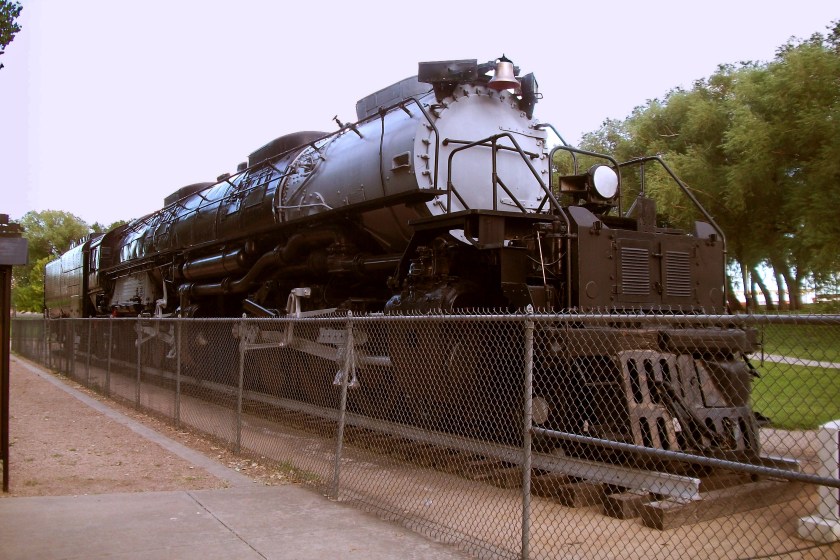
Getty Images, Rozdemir01
As you enter Holliday Park, you're met with a magnificent pond to your left where you can meander along the half-mile paved path to see geese, ducks, cormorants, and other lake life or sit on the beach and enjoy the scenery.
Just past the picnic benches along the far edge of the park sits the Big Boy Steam Engine, one of the last of its kind. The coal-fired engine of the steam locomotive was made to pull a 3,600-ton train from Cheyenne, Wyoming, to Ogden, Utah—a steep haul for such a heavy load. It's one impressive piece of machinery and much bigger than you'd think.
2. Wander Through the Botanic Gardens
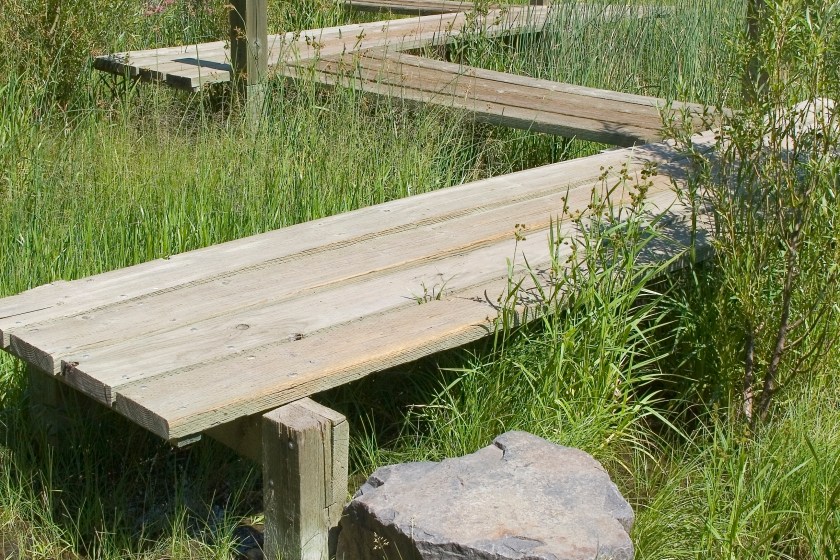
Getty Images, Jerry Hoopman
Cheyenne's Botanic Gardens is free to the public and open from dawn until dusk. While visitors have plenty to see both inside and out, the nine acres worth of outdoor gardens are an incredible sight, especially Discovery Pond. What was once a putrid, one-foot pond without any wildlife is now a stunning wetland boasting fish, birds, and other wildlife. Sit along the serene pond and look for fish from the gazebo or handicap-accessible dock. On the way back toward the greenhouses, walk through the Garden Labyrinth, where you may see additional local wildlife, such as rabbits, squirrels, and foxes, along with more ducks and geese.
Indoor exhibits include the Shane Smith Grand Conservatory, with its tropical plant collection, bonsai house, and naval submarine periscope; and the Paul Smith Children's Village, which has a wetlands area and a secret garden. Both have different hours based on the time of year, so check before you go.
3. Camp Out in Curt Gowdy State Park
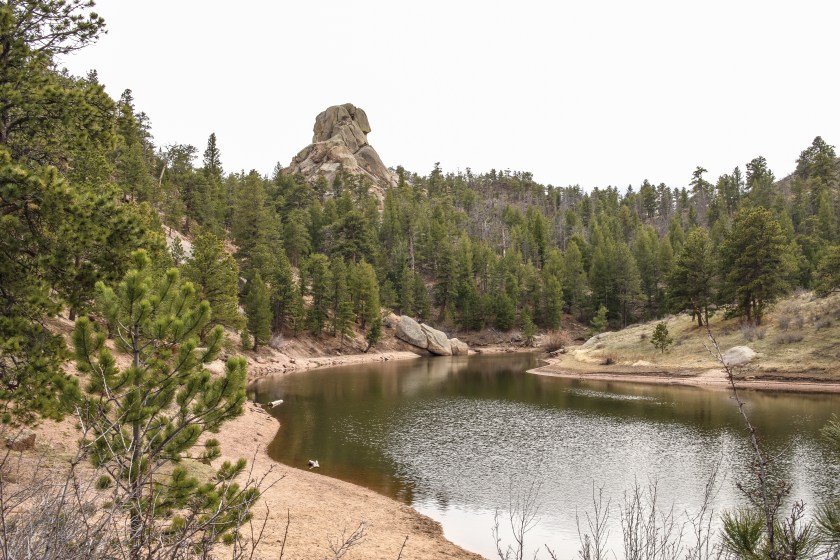
Getty Images, Roxanne Williams
Wyoming may have two impressive national parks, Yellowstone and Grand Teton National Park, but Cheyenne is home to a beautiful state park, Curt Gowdy State Park, named after the famed Wyoming-born sportscaster. Established in 1971, the park sits at the base of the Laramie Mountains midway between Cheyenne and Laramie, about 24 miles from each city.
As you enter, the visitor center and gift shop sit perched on the hillside, looking out over one of the park's three reservoirs, Granite, Crystal, and North Crow. The park is split into seven sections filled with different types of landscapes and plenty of plant and animal life to enjoy. While there, I saw geese, ducks, and deer throughout the park.
The recreation area is a great place for camping and RVing. The park also has cabin rentals for an off-the-grid getaway. If you're not into camping or you're looking for fun adventures on your trip, the park has plenty to offer.
4. Mountain Bike the Stone Temple Circuit
You don't need to stay over to take advantage of Curt Gowdy's mountain-bike trails. Despite many riders being on the trails, everyone was incredibly polite and friendly, abiding by the right-of-way rules for the trail and giving plenty of room for faster groups. Don't worry if you didn't bring a bike with you; you can rent one from Rock on Wheels in downtown. The staff there was amazing and made sure everyone in our group had a bike that was well suited to each individual's height, weight, and comfort level. It had been quite some time since I'd been on a bike that wasn't of the stationary variety, and I felt good careening down the hillside on the bike the guys set me up with.
At the trailhead, we took a few turns around the parking lot to get the feel for our bikes and headed up the trail to Stone Temple. Don't let Wyoming's flat appearance fool you. The park sits at 7,430 feet above sea level, and Stone Temple's trail takes you up almost 460 feet, which doesn't seem like that big of a climb on paper. As someone who doesn't hike above 6,000 feet, let me give you one huge piece of advice: That extra 1,500 feet is a big difference if you aren't used to it, and even more so the day after you fly in. The closer we got to the top, the more my lungs felt it. (I'm sure the dropping temperatures weren't helping, either.)
The 3.6-mile loop can be hiked if you prefer to stay off two wheels, but we didn't see many hikers on our trip. All Trails says the best time to hit the Stone Temple Circuit is between April and October to ensure good weather. I was there at the beginning of June, and we hit some inclement weather, which ended in us making a beeline for the truck as hail pummeled us. But I think the weather added to the fun—it was an epic mountain biking adventure.
5. Paddle Away on Granite Springs Reservoir
While swimming in the three reservoirs of Curt Gowdy is forbidden because they supply drinking water for the city (not to mention the water's frigid temperatures), Granite Springs Reservoir, as well as North Crow and Crystal, are open to kayakers and fishers. If you didn't bring your own kayak or paddleboard, you can rent them from a vendor, which is what I did. We enjoyed a leisurely paddle and spotted many families and campers fishing along the shoreline, hoping to snag a rainbow trout or kokanee salmon, both of which are common in these waters. Our guide even brought his pole out on the kayak but, unfortunately, didn't have any luck.
After pulling our boats out of the water, we did a little exploring on the other side of the park. We checked out the trails along Twin Lakes Creek and saw evidence of a beaver—cute little tracks coming out of the water—as well as some awesome-looking dams. While some of us checked out the fishing opportunities, the rest set out on an impromptu hike up the hillside on a dual-purpose hiking/biking path, which offered amazing views of the valley and reservoirs below.
6. Hike to Hidden Falls
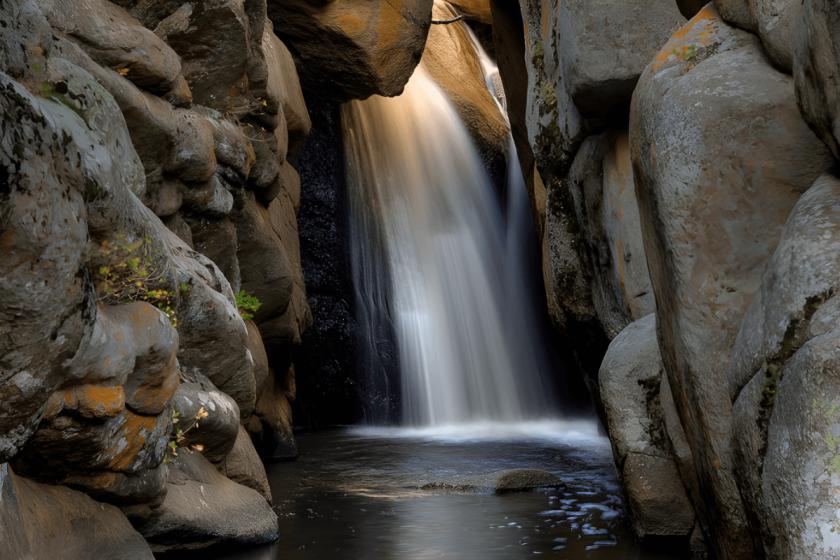
Visit Cheyenne
Another popular hiking adventure in Curt Gowdy is the Crow Creek Trail to Hidden Falls. The waterfall is tucked down a moderately challenging, 3.6-mile, out-and-back trail. It's marked by signs on the path, but it's easy to get off the trail—the visitors center offers maps if you're worried about getting lost. The trail is shared with mountain bikers, but everyone we encountered on foot and wheels was friendly and polite.
A few notes: If you use All Trails, its entry for Crow Creek Trail to Hidden Falls gives a different starting point than the park's, and many reviewers on the app said their trek measured more like 4 to 4.5 miles. Also, to get a really good look at the falls, you'll have to wade on it, so be sure to wear shoes that will keep you stable as you scramble over rocks.
You'll also find plenty of swimming holes along the trail if you need to cool off, and you can always pause to do a little fishing or scan the wilderness for wildlife, such as deer, beavers, geese, ducks, and the occasional moose.
7. Enjoy the Rodeo at Cheyenne Frontier Days
Held every summer since 1897, Cheyenne Frontier Days is a 10-day festival that touts itself as the "World's Largest Outdoor Rodeo and Western Celebration." Affectionately called the "Big Daddy of the All," Frontier Days includes concerts, parades, a chuckwagon cookoff, carnival rides and shows, a pancake breakfast, and—of course—one heck of a rodeo. People come from all around the U.S. to watch rodeo pros compete for over $1 million in prizes. Between events or before the concerts, you may also visit the Indian Village to learn more about Native American tribes through exhibits, dancing, music, and storytelling, and shop vendor booths selling food and wares. While you're there, be sure to note the amazing bronze statues around the arena.
If you can't make it to town during the celebration, heading to Cheyenne's Old West Museum might be the next best thing. The museum features exhibits detailing the city's roots. Wander through the decades, learning the stories of cowboys as well as Hollywood and Nashville stars.
8. Take the Train Through Terry Bison Ranch
The Terry Bison Ranch is one of the few places that allows you to have a more hands-on experience with bison—not something we'd recommend in the wild. More than 2,300 bison graze along the plains of this 30,000-acre ranch, but you can't just walk up to the large animals. The ranch's bison train takes you through the fields, allowing you to lean out and even feed them. Seats can't be reserved beforehand, so it's first come, first served, and tours run once every two hours. The ranch also offers horseback riding if you want to hop in the saddle, and visitors can see animals such as goats, donkeys, and ostriches as well.
After a day on the ranch, grab a seat at The Senator's Restaurant and Brass Buffalo Saloon to fill your stomach with bison burgers, and maybe give the casino slots a try.
9. Scramble Over Granite at Vedauwoo Recreation Area
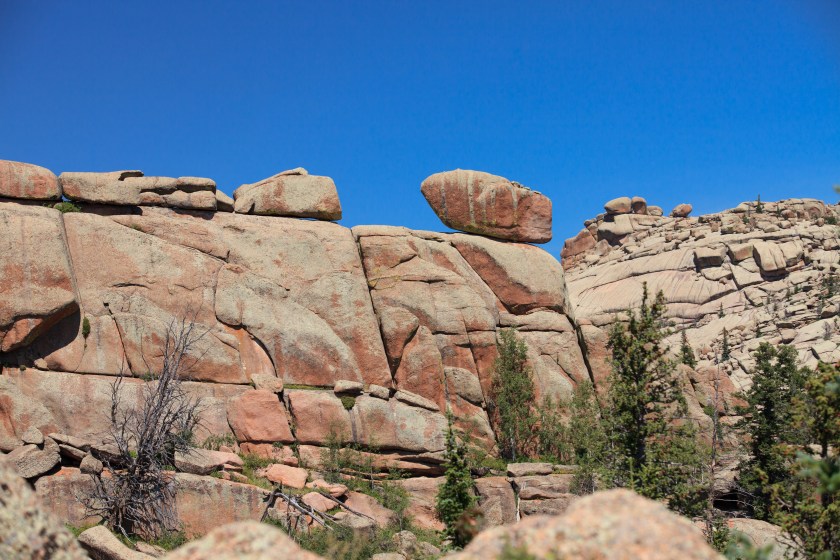
Getty Images, Imre Cikajio
Wyoming's Vedauwoo Recreation Area attract rock-climbing enthusiasts of all skill levels to scale up 1.4 billion-year-old granite monoliths, including areas with snowy or sheer ascents. Located between Laramie and Cheyenne in the Medicine Bow National Forest, the area sits at 8,200 feet. The national forest itself encompasses two million acres of land that is open to the public. Famous for its wide crack or "off widths" rock formations, Vedauwoo offers climbers more 1,000 different options, making it a place you could explore for a few days or more if you have the time (and stamina).
Fall Wall is a crowd favorite. The lower section is better suited for beginner or intermediate climbers with plenty of anchors in place. The upper section has wide cracks with rock outcroppings and isn't for the faint of heart: It's climbing routes sport names like Neon Madman, Mickey Mantle, and Krypton Sociopath.
In addition to rock climbing, the area has hiking and mountain biking, as well as camping spots for boondocking RVs and tents. Campsites are first come, first served, and amenities are sparse, with vault toilets, a fire ring, and a water pump with drinkable water. The grounds—surrounded by the rocks and sitting among the limber pine, Aspen, Douglas fir, and Engleman spruce trees—are meant to blend in with nature. According to the U.S. Forest Service, Vendauwoo was a hideout for outlaws, and the Arapaho Indians believed "playful spirits" lived within the formations.
10. Stroll—and Eat—Your Way Through Downtown Cheyenne
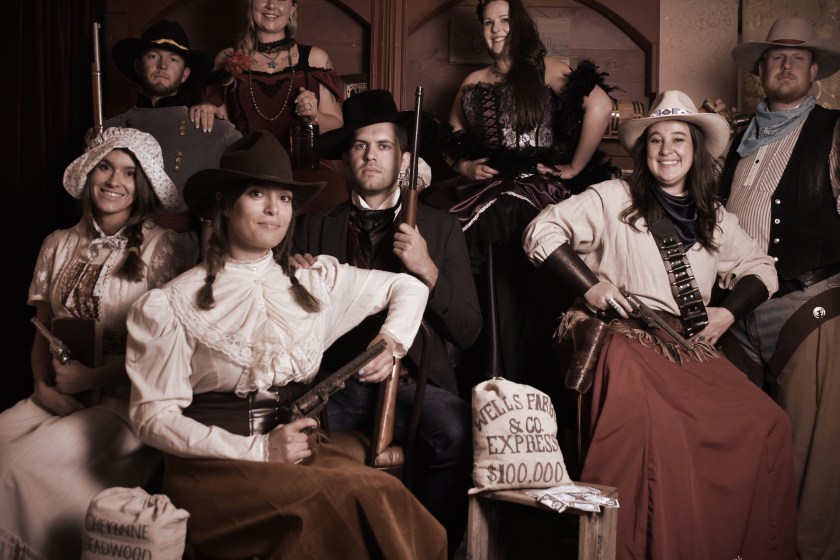
Emmas Old Time Photos
Walking through the downtown of any city is a must-do when traveling, but Cheyenne's small-town feel in a capital city makes it unique. Historic downtown Cheyenne is filled with adorable antique stores, businesses, restaurants, and museums. One of our favorites was our visit to Emma's Old Time Photos, where we had a great time dressing up as outlaws, cowboys, soldiers, and even madams.
Throughout the downtown area you'll also find the Cheyenne "big boots." Grab a map from the Cheyenne Depot Museum to track how many of the 35-plus, 8-foot tall cowboy boots you spot on your visit.
To the left of the main plaza is the historical building dubbed The Wrangler. The bright red structure is a hard-to-miss landmark and has been standing since the late 1800s. Once a hotel, the building is now a Boot Barn. However, the company agreed to honor the historical significance of the building by keeping the original name.
After a long day of outdoor adventures, you've likely worked up a hearty appetite. The downtown restaurant scene does not disappoint. As someone who is gluten- and grain-free, eating while traveling can be a little intimidating, and I'm thrilled to say I found plenty of fabulous restaurants to suit a variety of dietary needs, such as the Metropolitan, where I had an excellent pan-seared salmon and solid drinks—the champagne lemon-drop is to die for! was also impressed with the excellent Thai food at Anong's Thai Cuisine.
For lunch, consider the Bunkhouse, The Albany, or 2 Doors Down—loved the burgers. Breakfast spots didn't disappoint, either. Some great ones are Luxury Diner, Down Home Cafe, and the Omlet House. If you're looking for a treat, try the "Courson Comb": grabbing lunch from La Paz and taking it over to The Blue Room's dining area to enjoy some drinks while sitting in the outdoor dining area and listening to live music.
11. Hitch a Ride on the Cheyenne Street Railway Trolley
You might question whether riding an old trolley through a city's historic district would be the most scintillating attraction when looking for outdoor adventures. However, like most things about Cheyenne, Wyoming, you'd be wrong.
The docents on the Cheyenne Street Railway Trolley are incredibly knowledgeable about Cheyenne and Wyoming history and weave fascinating tales about the historical buildings and points in town, including Cattle Baron Row and the Governor's Mansion.The trolley also takes you past the Wyoming State Capitol building, whose cornerstone was laid in 1887. Our guide happened to be married to the lovely gal behind Emma's Old Time Photos and was an absolute hoot. His spiel combined the right amount of accuracy, scandal, and humor.
The 90-minute Wild West History tour is completely worth it. The trolley runs year-round, with a special Cheyenne ghost tours in October and a Christmas Lights tour in December.
12. Make a Pitstop at Cheyenne Depot Museum
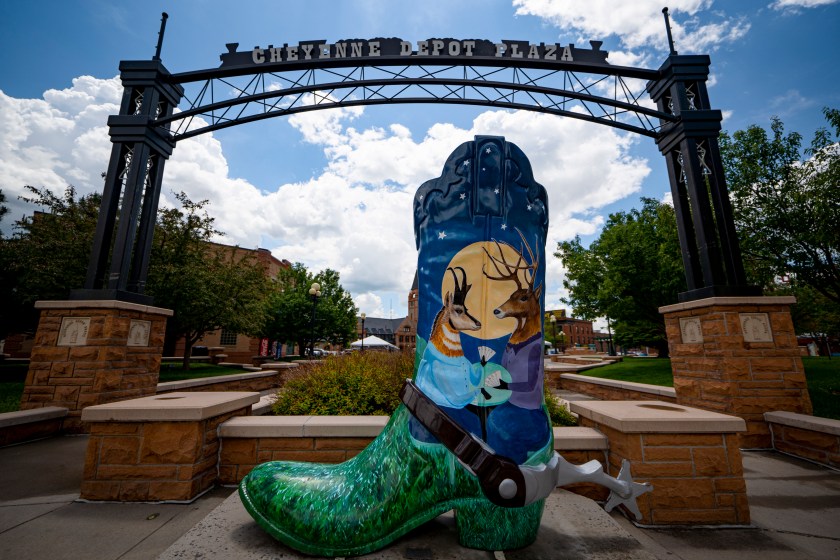
Getty Images, Autumn Parry
While it may be an indoor attraction, the Depot Museum is a must-see if you visit Cheyenne. It's a magnificent national historic landmark at the center of downtown, and the only remaining 19th-century depot on the Transcontinental Railroad. The gorgeous building, designed by Henry Van Brunt, now stands tall like a historical beacon with a steepled clock tower and semicircular arches.
Walking through the doors, you step on the beautifully marbled floors with intricate ceilings above you, and museum exhibits to your right, featuring train history and interactive displays. The self-guided tour can take an hour to two hours, depending on how much time you spend at each display.
Undeniably, examining the breathtaking 800-square foot model of the Union Central and Northern Railroad upstairs will take you the most amount of time. Designed and built by Harry Brunk, the intricate model draws you in at every twist and turn of the railway. And if that doesn't, hunting for the hidden dinosaurs will keep you there for a while. (We found them all on our visit.)
The Cheyenne Depot Plaza in front of the museum often offers live music and has frequent events with local artists, especially during Fridays on the Plaza, which runs from June through August.
If you're looking for another museum to visit while downtown, check out the Cowgirls of the West Museum & Emporium. The museum highlights the history of legendary Western women, including native American interpreter Sacagawea and cowgirls like Annie Oakley, Dell Burke, and Mary Carter.
READ MORE: Wyoming Hunting: What Puts the Cowboy State Over the Others?
